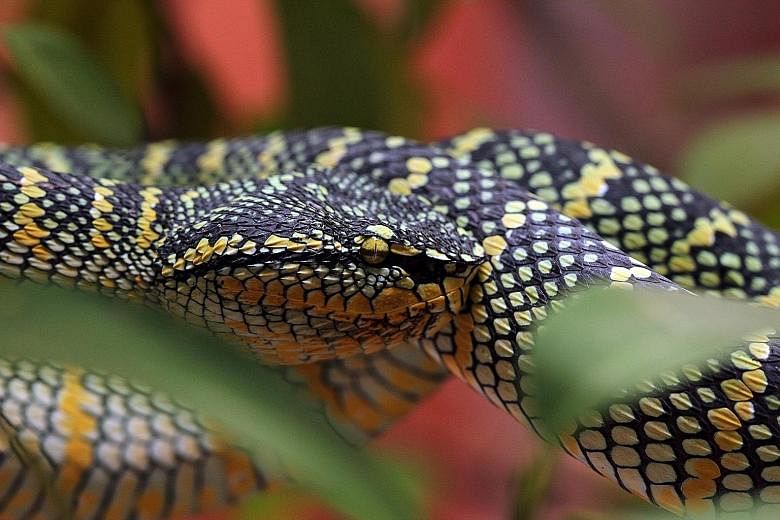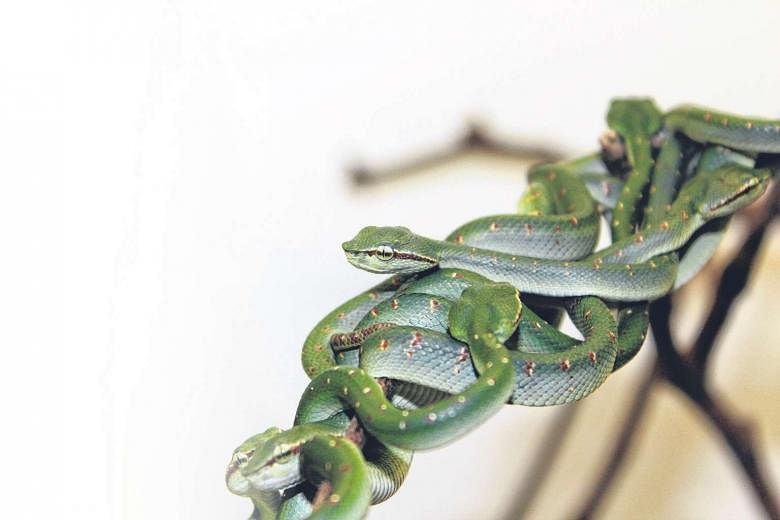Lurking in the nature reserves and parks of Singapore is a peculiar snake not known to many.
The temple pitviper is sexually dimorphic (distinct) - the males are green while the much larger females sport black, white and yellow scales, although both start off as green baby snakes known as snakelets.
It is the only snake species known to produce a toxin called waglerin - a neuromuscular inhibitor which scientists believe could be developed into a muscle relaxant drug.
These unique attributes of the non-aggressive but venomous snake, found in Singapore's Central Catchment Nature Reserve, MacRitchie Reservoir Park and Upper and Lower Peirce Reservoir Parks, are the reason why researchers from the National University of Singapore (NUS) want to sequence its entire genome.
The team from the NUS Department of Biological Sciences is up against four other international teams in the 2017 Plant and Animal SMRT Grant Programme competition, organised by biotechnology firm Pacific Biosciences (PacBio).
The winner gets to sequence the animal of its choice to map out its genetic make-up, using a technique known as single molecule, real- time (SMRT) sequencing technology. The other teams are fighting to sequence the dingo, an explosive beetle, a pink pigeon or a solar- power slug.
These top five finalists were selected by a committee of scientists, but now anyone can vote to decide on the winner.
Scientists began sequencing the genomes of small, simple organisms in the 1970s. As techniques improved, this opened the door to doing so for more complex ones.
The Human Genome Project (HGP) - an international effort to sequence and map all of the genes in a person - was completed with much fanfare in 2003, giving scientists the ability, for the first time, to read nature's complete genetic blueprint for building a human being.
Since then, sequencing technology has become much more advanced and many times cheaper. Among the many animals to join the list are the mouse, pufferfish and chimpanzee.
Professor Manjunatha Kini, the leader of the NUS team, said that by sequencing the temple pitviper's genome, scientists will have a complete set of information on the snake's genes, which will help them to understand the origins of proteins expressed in the snake's venom gland.
Prof Kini said proteins expressed in the venom glands of snakes can originate in the liver, for instance, but over millions of years get duplicated and eventually expressed in the venom gland where they go haywire.
A blood-clotting gene produced in the liver is regulated such that it does no harm, for instance, but the duplicate produced in the venom gland can kill.
"Once you start understanding why gene duplication occurs, and learn to control it, you can generate a lot of new molecules through gene duplication," Prof Kini explained.
Research fellow Mrinalini, who goes by one name, is also involved in the project and noted that although snakes kill 100,000 people each year, they have saved the lives of millions.
Captopril, a drug commonly used to treat hypertension, for example, was developed from the venom of the Brazilian pit viper, while eptifibatide and tirofiban, used to treat heart conditions such as angina, were developed from the venoms of the dusky pygmy rattlesnake and saw-scaled viper respectively.
"We want to raise awareness about snakes and their venoms, and how these toxins can benefit humans," said Dr Mrinalini.
•Votes can be made at http://www.pacb.com/smrt-science/smrt-grant/pag2017/
•The competition ends on April 5.


